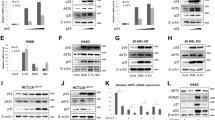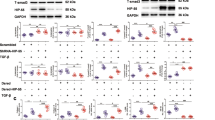Abstract
Transforming growth factor-β (TGF-β) and TGF-β-related factors induce apoptosis in a variety of tissues; however, the mechanism underlying this induction is largely unknown. Here, we demonstrate that TGF-β induces the expression of the death-associated protein kinase (DAP-kinase) as an immediate early response in cells that undergo apoptosis in response to TGF-β. DAP-kinase is a positive mediator of apoptosis induced by certain cytokines and oncogenes. We show that the DAP-kinase promoter is activated by TGF-β through the action of Smad2, Smad3 and Smad4. Overexpression of DAP-kinase triggers apoptosis in the absence of TGF-β, whereas inhibition of DAP-kinase activity protects cells from TGF-β-induced apoptosis, blocks TGF-β-induced release of cytochrome c from mitochondria and prevents TGF-β-induced dissipation of the mitochondrial membrane potential. Our findings indicate that DAP-kinase mediates TGF-β-dependent apoptosis by linking Smads to mitochondrial-based pro-apoptotic events.
This is a preview of subscription content, access via your institution
Access options
Subscribe to this journal
Receive 12 print issues and online access
$209.00 per year
only $17.42 per issue
Buy this article
- Purchase on Springer Link
- Instant access to full article PDF
Prices may be subject to local taxes which are calculated during checkout








Similar content being viewed by others
Accession codes
References
Derynck, R. & Feng, X.-H. TGF-β receptor signaling. Biochim. Biophys. Acta. 1333, F105–F150 (1997).
Massague, J. TGF-β signal transduction. Annu. Rev. Biochem. 67, 753–791 (1998).
Chen, R. H. & Chang, T. Y. Involvement of caspase family proteases in transforming growth factor-β-induced apoptosis. Cell Growth Differ. 8, 821–827 (1997).
Oberhammer, F. A. et al. Induction of apoptosis in cultured hepatocytes and in regressing liver by transforming growth factor-β1. Proc. Natl Acad. Sci. USA 89, 5408–5412 (1992).
Takiya, S. et al. Role of transforming growth factor β1 on hepatic regeneration and apoptosis in liver diseases. J. Clin. Pathol. 48, 1093–1097 (1995).
Chaouchi, N. et al. Characterization of transforming growth factor-β1 induced apoptosis in normal human B cells and lymphoma B cell lines. Oncogene 11, 1615–1622 (1995).
Brodin, G. et al. Increased smad expression and activation are associated with apoptosis in normal and malignant prostate after castration. Cancer Res. 59, 2731–2738 (1999).
Yokouchi, Y. et al. BMP-2/-4 mediate programmed cell death in chicken limb bud. Development 122, 3725–3734 (1996).
Macias, D. et al. Role of BMP-2 and OP-1 (BMP-7) in programmed cell death and skeletogenesis during chick limb development. Development 124, 1109–1117 (1997).
Zou, H. & Niswander, L. Requirement for BMP signaling in interdigital apoptosis and scale formation. Science 272, 738–741 (1996).
Merino, R. et al. Bone morphogenetic proteins regulate interdigital cell death in the avian embryo. Ann. NY Acad. Sci. 887, 120–132 (1999).
Selvakumaran, M., Liebermann, D. & Hoffman-Liebermann, B. Myeloblastic leukemia cells conditionally blocked by myc-estrogen receptor chimeric transgenes for terminal differentiation coupled to growth arrest and apoptosis. Blood 81, 2257–2262 (1993).
Foitzik, K. et al. Control of murine hair follicle regression (catagen) by TGF-β1 in vivo. FASEB J. 14, 752–760 (2000).
Wrana, J. L. et al. Mechanism of activation of the TGF-β receptor. Nature 370, 341–347 (1994).
Lagna, G., Hata, A., Hemmati-Brivanlou, A. & Massague, J. Partnership between DPC4 and SMAD proteins in TGF-β signalling pathways. Nature 383, 832–836 (1996).
Macias-Silva, M. et al. MADR2 is a substrate of the TGFβ receptor and its phosphorylation is required for nuclear accumulation and signaling. Cell 87, 1215–1224 (1996).
Zhang, Y., Feng, X., Wu, R. & Derynck, R. Receptor-associated Mad homologues synergize as effectors of the TGF-β response. Nature 383, 168–172 (1996).
Nakao, A. et al. TGF-β receptor-mediated signalling through Smad2, Smad3 and Smad4. EMBO J. 16, 5353–5362 (1997).
Attisano, L. & Wrana, J. L. Smads as transcriptional co-modulators. Curr. Opin. Cell Biol. 12, 235–243 (2000).
Massague, J. & Wotton, D. Transcriptional control by the TGF-β/Smad signaling system. EMBO J. 19, 1745–1754 (2000).
ten Dijke, P., Miyazono, K. & Heldin, C. H. Signaling inputs converge on nuclear effectors in TGF-β signaling. Trends Biochem. Sci. 25, 64–70 (2000).
Zhang, Y. & Derynck, R. Regulation of Smad signalling by protein associations and signalling crosstalk. Trends Cell Biol. 9, 274–279 (1999).
Hayashi, H. et al. The MAD-related protein Smad7 associates with the TGF-β receptor and functions as an antagonist of TGFβ signaling. Cell 89, 1165–1173 (1997).
Imamura, T. et al. Smad6 inhibits signalling by the TGF-β superfamily. Nature 389, 622–626 (1997).
Sanchez, A., Alvarez, A. M., Benito, M. & Fabregat, I. Apoptosis induced by transforming growth factor-β in fetal hepatocyte primary cultures: involvement of reactive oxygen intermediates. J. Biol. Chem. 271, 7416–7422 (1996).
Selvakumaran, M. et al. The novel primary response gene MyD118 and the proto-oncogene myb, myc and Bcl2 modulate transforming growth factor-β1-induced apoptosis. Mol. Cell Biol. 14, 2352–2360 (1994).
Saltzman, A. et al. Transforming growth factor-β-mediated apoptosis in the Ramos B-lymphoma cell line is accompanied by caspase activation and Bcl-XL downregulation. Exp. Cell Res. 242, 244–254 (1998).
Larisch-Bloch, S. et al. Selective loss of the transforming growth factor-β apoptotic signaling pathway in mutant NRP-154 rat prostatic epithelial cells. Cell Growth Differ. 11, 1–10 (2000).
Larisch, S. et al. A novel mitochondrial septin-like protein, ARTS, mediates apoptosis dependent on its P-loop motif. Nature Cell Biol. 2, 915–921 (2000).
Patil, S. et al. Smad7 is induced by CD40 and protects WEHI 231 B-lymphocytes from TGFβ-induced growth inhibition and apoptosis. J. Biol. Chem. 275, 38363–38370 (2000).
Yamamura, Y., Hua, X., Bergelson, S. & Lodish, H. F. Critical role of smads and AP-1 complex in TGF-β-dependent apoptosis. J. Biol. Chem. 275, 36295–36302 (2000).
Massague, J. How cells read TGF-β signals. Nature Rev. Mol. Cell Biol. 1, 169–178 (2000).
Deiss, L. P. et al. Identification of a novel serine/threonine kinase and a novel 15-kD protein as potential mediators of the γ-interferon-induced cell death. Genes Dev. 9, 15–30 (1995).
Cohen, O., Feinstein, E. & Kimchi, A. DAP-kinase is a Ca2+/calmodulin-dependent, cytoskeletal-associated protein kinase, with cell death-inducing functions that depend on its catalytic activity. EMBO J. 16, 998–1008 (1997).
Cohen, O. et al. DAP-kinase participates in TNF-α- and Fas-induced apoptosis and its function requires the death domain. J. Cell Biol. 146, 141–148 (1999).
Raveh, T. et al. DAP kinase activates a p19ARF/p53-mediated apoptotic checkpoint to suppress oncogenic transformation. Nature Cell Biol. 3, 1–7 (2001).
Buzby, J. S. et al. Increased granulocyte-macrophage colony-stimulating factor mRNA instability in cord versus adult mononuclear cells is translation-dependent and associated with increased levels of A+U-rich element binding factor. Blood 88, 2889–2897 (1996).
Kissil, J. L. et al. DAP-kinase loss of expression in various carcinoma and B-cell lymphoma cell line: Possible implication for roles as tumor suppressor genes. Oncogene 15, 403–407 (1997).
Green, D. R. & Reed, J. C. Mitochondria and apoptosis. Science 281, 1309–1312 (1998).
Park, U. S. et al. Hepatitis B virus-X protein upregulates the expression of p21waf1/cip1 and prolongs G1 to S transition via a p53-independent pathway in human hepatoma cells. Oncogene 19, 3384–3394 (2000).
Shi, Y. et al. Crystal structure of a Smad MH1 domain bound to DNA: insights on DNA binding in TGF-β signaling. Cell 94, 585–594 (1998).
Hanai, J. et al. Interaction and functional cooperation of PEBP2/CBF with Smads. Synergistic induction of the immunoglobulin germline Cα promoter. J. Biol. Chem. 274, 31577–31582 (1999).
Pardali, E. et al. Smad and AML proteins synergistically confer transforming growth factor-β1 responsiveness to human germ-line IgA genes. J. Biol. Chem. 275, 3552–3560 (2000).
Zhang, Y. & Derynck, R. Transcriptional regulation of the transforming growth factor-β-inducible mouse germ line Ig-α constant region gene by functional cooperation of Smad, CREB, and AML family members. J. Biol. Chem. 275, 16979–16985 (2000).
Aravind, L., Dixit, V. M. & Koonin, E. V. Apoptotic molecular machinery: vastly increased complexity in vertebrates revealed by genome comparisons. Science 291, 1279–1284 (2001).
Chen, J. J. et al. Profiling expression patterns and isolating differentially expressed genes by cDNA microarray system with colorimetry detection. Genomics 51, 313–324 (1998).
Feng, X.-H., Filvaroff, E. H. & Derynck, R. Transforming growth factor-β (TGF-β)-induced down-regulation of cyclin A expression requires a functional TGF-β receptor complex. J. Biol. Chem. 270, 24237–24245 (1995).
He, T. C. et al. A simplified system for generating recombinant adenoviruses. Proc. Natl Acad. Sci. USA 95, 2509–2514 (1998).
Chen, R. H., Su, Y. H., Chuang, R. L. & Chang, T. Y. Suppression of transforming growth factor-β-induced apoptosis through a phosphatidylinositol 3-kinase/Akt-dependent pathway. Oncogene 17, 1959–1968 (1998).
Feng, X. H. & Derynck, R. Ligand-independent activation of transforming growth factor (TGF) β signaling by heteromeric cytoplasmic domains of TGF-beta receptors. J. Biol. Chem. 271, 13123–13129 (1996).
Acknowledgements
We thank R. Derynck, X.-H. Feng, M. Kawabata, A. Nakao and C.-H. Heldin for various Smad constructs, Smad adenoviruses and Smad null cells, and B. Vogelstein for recombinant adenovirus vector systems. We also thank R. Derynck for critical reading of the manuscript, K. Peck and C.-H. Tsai for instructions on microarray analysis, C.-N. Tsai for advice on the recombinant adenovirus construction and G. Lin for his help in the initial phase of this research. This work was supported by National Science Council Frontier Grant 90-2321-B-002-004 to R.-H.C.
Author information
Authors and Affiliations
Corresponding author
Supplementary information
Table S1
List of genes whose expression was not altered by TGF- treatment of Hep3B cells. (PDF 68 kb)
Rights and permissions
About this article
Cite this article
Jang, CW., Chen, CH., Chen, CC. et al. TGF-β induces apoptosis through Smad-mediated expression of DAP-kinase. Nat Cell Biol 4, 51–58 (2002). https://doi.org/10.1038/ncb731
Received:
Revised:
Accepted:
Published:
Issue Date:
DOI: https://doi.org/10.1038/ncb731
This article is cited by
-
Enhancer hijacking at the ARHGAP36 locus is associated with connective tissue to bone transformation
Nature Communications (2023)
-
Long noncoding RNA BCRP3 stimulates VPS34 and autophagy activities to promote protein homeostasis and cell survival
Journal of Biomedical Science (2022)
-
Long noncoding RNA Smyca coactivates TGF-β/Smad and Myc pathways to drive tumor progression
Journal of Hematology & Oncology (2022)
-
Classical epithelial-mesenchymal transition (EMT) and alternative cell death process-driven blebbishield metastatic-witch (BMW) pathways to cancer metastasis
Signal Transduction and Targeted Therapy (2022)
-
Regulation of DAPK1 by Natural Products: An Important Target in Treatment of Stroke
Neurochemical Research (2022)



